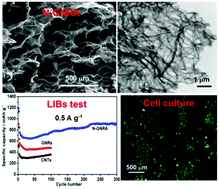Multifunctional nitrogen-doped graphene nanoribbon aerogels for superior lithium storage and cell culture†
Abstract
Nitrogen-doped graphene nanoribbon aerogels (N-GNRAs) are fabricated through the self-assembly of graphene oxide nanoribbons (GONRs) combined with a thermal annealing process. Amino-groups are grafted to the surface of graphene nanoribbons (GNRs) by an epoxy ring-opening reaction. High nitrogen doping level (7.6 atm% as confirmed by elemental analysis) is achieved during thermal treatment resulting from functionalization and the rich edge structures of GNRs. The three dimensional (3D) N-GNRAs feature a hierarchical porous structure. The quasi-one dimensional (1D) GNRs act as the building blocks for the construction of fishnet-like GNR sheets, which further create 3D frameworks with micrometer-scale pores. The edge effect of GNRs combined with nitrogen doping and porosity give rise to good electrical conductivity, superhydrophilic, highly compressible and low density GNRAs. As a result, a high capacity of 910 mA h g−1 is achieved at a current density of 0.5 A g−1 when they are tested as anode materials for lithium ion batteries. Further cell culture experiments with the GNRAs as human medulloblastoma DAOY cell scaffolds demonstrate their good biocompatibility, inferring potential applications in the biomedical field.


 Please wait while we load your content...
Please wait while we load your content...